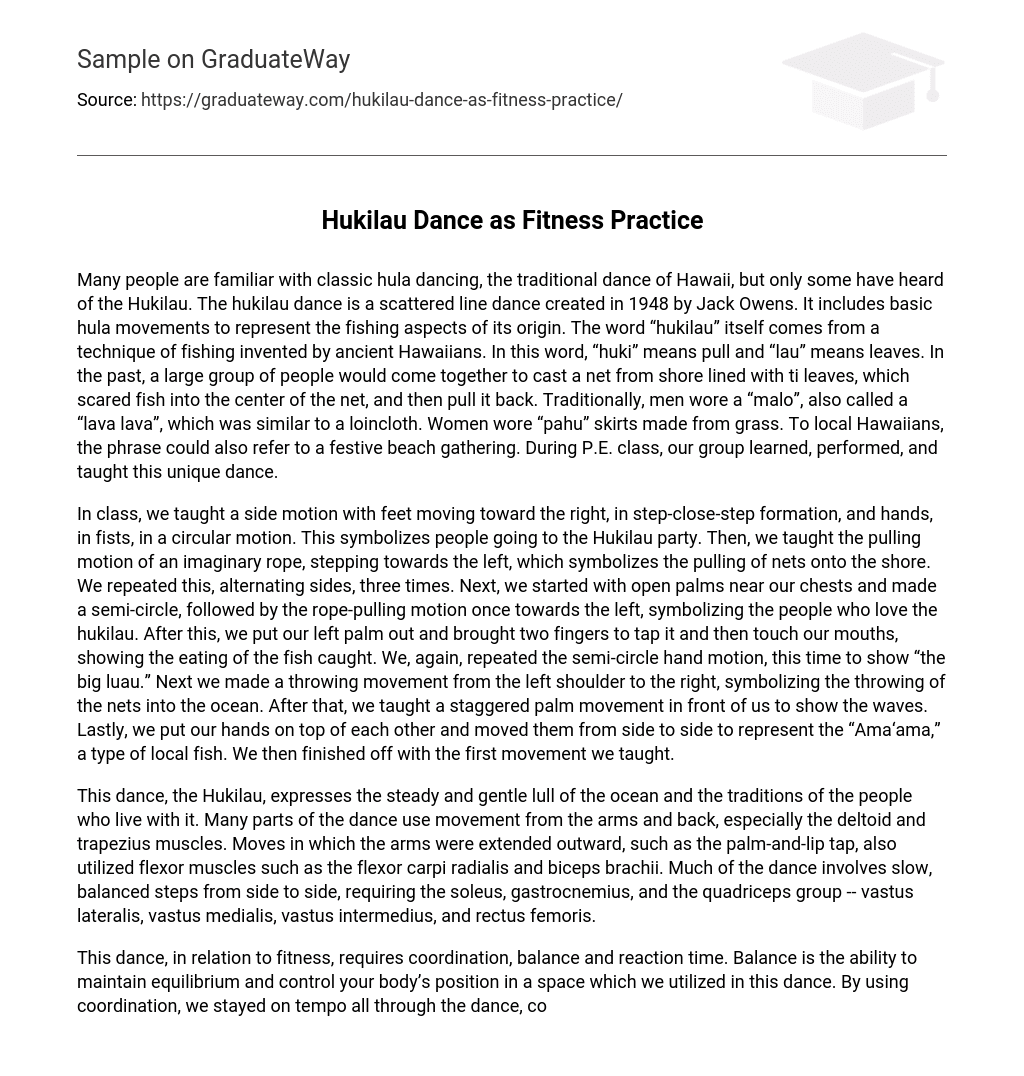Many people are familiar with classic hula dancing, the traditional dance of Hawaii, but only some have heard of the Hukilau. The hukilau dance is a scattered line dance created in 1948 by Jack Owens. It includes basic hula movements to represent the fishing aspects of its origin. The word “hukilau” itself comes from a technique of fishing invented by ancient Hawaiians. In this word, “huki” means pull and “lau” means leaves. In the past, a large group of people would come together to cast a net from shore lined with ti leaves, which scared fish into the center of the net, and then pull it back. Traditionally, men wore a “malo”, also called a “lava lava”, which was similar to a loincloth. Women wore “pahu” skirts made from grass. To local Hawaiians, the phrase could also refer to a festive beach gathering. During P.E. class, our group learned, performed, and taught this unique dance.
In class, we taught a side motion with feet moving toward the right, in step-close-step formation, and hands, in fists, in a circular motion. This symbolizes people going to the Hukilau party. Then, we taught the pulling motion of an imaginary rope, stepping towards the left, which symbolizes the pulling of nets onto the shore. We repeated this, alternating sides, three times. Next, we started with open palms near our chests and made a semi-circle, followed by the rope-pulling motion once towards the left, symbolizing the people who love the hukilau. After this, we put our left palm out and brought two fingers to tap it and then touch our mouths, showing the eating of the fish caught. We, again, repeated the semi-circle hand motion, this time to show “the big luau.” Next we made a throwing movement from the left shoulder to the right, symbolizing the throwing of the nets into the ocean. After that, we taught a staggered palm movement in front of us to show the waves. Lastly, we put our hands on top of each other and moved them from side to side to represent the “Ama‘ama,” a type of local fish. We then finished off with the first movement we taught.
This dance, the Hukilau, expresses the steady and gentle lull of the ocean and the traditions of the people who live with it. Many parts of the dance use movement from the arms and back, especially the deltoid and trapezius muscles. Moves in which the arms were extended outward, such as the palm-and-lip tap, also utilized flexor muscles such as the flexor carpi radialis and biceps brachii. Much of the dance involves slow, balanced steps from side to side, requiring the soleus, gastrocnemius, and the quadriceps group — vastus lateralis, vastus medialis, vastus intermedius, and rectus femoris.
This dance, in relation to fitness, requires coordination, balance and reaction time. Balance is the ability to maintain equilibrium and control your body’s position in a space which we utilized in this dance. By using coordination, we stayed on tempo all through the dance, coordinating with each others’ footsteps and movements. Reaction time is the time it takes for the dancers to react to the music, which we feel we incorporated. The positive benefits of dancing that can be applied in fitness would be improved reaction time, which could be used to react to our opponents’ moves in a game such as basketball. Reaction time can also be used in other, everyday scenarios, such as avoiding a car crash. Coordination can also be incorporated in sports — such as in soccer, when it is focused between the eyes, leg and ball. We do not think this dance could be done as an intensive exercise because it is a slow-moving dance with not all that many body movements used other than the feet, hips, and arms. However, it can improve the health of some arm muscles and lessen stiffness.
The Hukilau is a dance that requires group work in order to be performed properly and smoothly. We all had to have the discipline and motivation to practice at home so that we could remember our moves and bring our own costumes. Each member had to be accountable for their own movements on behalf of the group. In this sense, dancing in a group is different. Each member is accountable for their own actions, which directly affects the group’s overall performance. Unlike other sports where one person can take the lead, no one can slack off in a group dance. For example, each member of our group had their own special and pivotal roles in the process and the final result of our one week period of practice. Tiana first figured out the dance and its beat counts, so she helped set the foundation for the learning of our dance. Medha brought speakers that greatly helped us coordinate with the song during practice, and encouraged other teammates while practicing. She and Tiana helped coordinate and choreograph the various dance formations and the overall sequence. Dhanya and Laura each brought a skirt for Allison on the day of our presentation. Yawen was punctual and present during all of our meetings outside of the ones held during P.E.. Allison constantly improved on the dance and diligently took notes on the formations and movements. Laura gave helpful tips on how to execute parts others were struggling with and helped the team stay concentrated during planning and practice. Dhanya contributed by her enthusiasm and encouragement while practicing. Laura, Medha, and Tiana taught the class the Hukilau on the presentation day.





